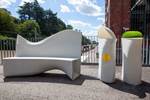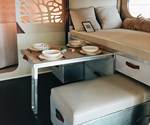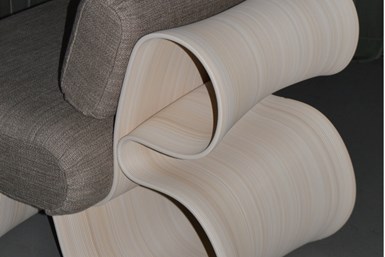Hyfer Objects furniture incorporates Sulapac wood composites
High-end design furniture is 3D printed from bio-based, eco-friendly materials for aesthetic and sustainable home product options.
Sulapac’s (Helskinki, Finland) bio-based, eco-friendly wood composites materials are now being incorporated into Hyfer Objects’ (previously Ekbacken Studios, Stockholm, Sweden) entire signature Collection no.1 of environmentally conscious “masterpiece” furniture. The continued partnership with 3D technology company, The Industry (Malmö, Finland) ensures that the trio are merging technology and sustainability to produce high-end furniture locally.
The incorporation of Sulapac’s materials indicate Hyfer’s committment against environmental degradation while producing high-end design pieces. Made of biodegradable biopolymers and natural wood, Sulapac leaves no permanent microplastics or toxic residues behind. The wood originates from industrial side streams, and in the future, will also use recycled biopolymers. Moreover, the materials have a low carbon footprint compared to conventional plastic.
Learn more about Supalac materials, “Sulapac introduces Sulapac Flow 1.7 to replace PLA, ABS and PP in FDM, FGF”
Hyfer Objects is dedicated to creativity, quality and environmental responsibility. It aims to continue its focus on using a variation of circular materials to create luxurious design pieces.
“It’s inspiring to see how seamlessly Sulapac material and Hyfer’s contemporary designs play together,” Juho Luukkanen, sales director at Sulapac, says. “It’s a pleasure to work with another Nordic forerunner willing to challenge the status quo while fostering a culture of excellence.”
Besides 3D printing, the Sulapac portfolio includes materials for injection molding, extrusion and thermoforming.
Related Content
-
Time Bicycles to modernize composite bicycle manufacturing
With the aid of KraussMaffei, Clemson University and SC Fraunhofer USA Alliance, Time anticipates a transition to HP-RTM for more efficient carbon fiber bike frame manufacture, plus a new facility in South Carolina.
-
Mito Materials graphene amplify composite fly fishing rod performance
Functionalized graphene addition to premium-performance Evos and Evos Salt fly rods by St. Croix Fly enables faster recovery, increased torsional rigidity and improved strength-to-weight ratios.
-
Composites end markets: Electronics (2024)
Increasingly, prototype and production-ready smart devices featuring thermoplastic composite cases and other components provide lightweight, optimized sustainable alternatives to metal.

















